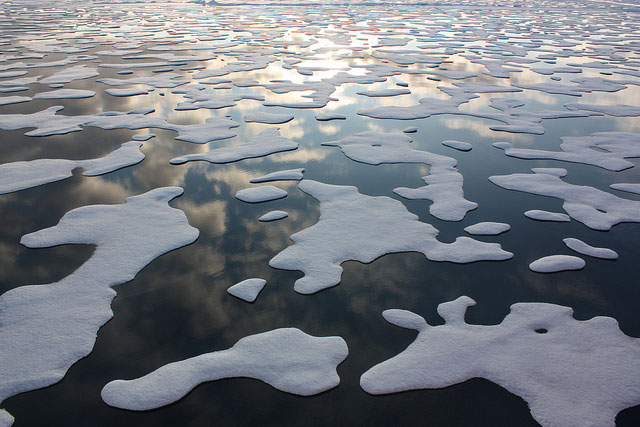
Part of the Series
Planet or Profit
Climate scientists tracking anthropogenic climate disruption (ACD) have long feared what is referred to as a blue ocean event.
A blue ocean event means a complete absence of Arctic sea ice, allowing the heat of the sun to fully penetrate the open waters of the Arctic, which would then dramatically accelerate the rate of warming in the Arctic.
This dramatic shift would then cause a profound disruption of both atmospheric and ocean-current circulation around the globe, contributing to an increasingly ice-free Arctic, rising sea levels and dramatic increases in ACD everywhere.
To see more stories like this, visit “Planet or Profit?”
This March, Truthout reported on the Arctic sea ice nearing a record low total volume, a measure that many scientists believe to be the single most important factor in determining the health of the Arctic sea ice. That same month, NASA reported that the winter Arctic sea ice extent had already hit an all-time low.
These trends, coupled with ongoing record heating in the Arctic, mean that it is not out of the realm of possibility that the blue ocean event could occur as early as this September.
The Importance of Arctic Sea Ice
The role of Arctic sea ice to the global climate is made clear by the National Snow and Ice Data Center, which has emphasized that this ice works to keep the polar regions of the planet cool and moderate the global climate.
According to the Data Center: “Sea ice has a bright surface; 80 percent of the sunlight that strikes it is reflected back into space. As sea ice melts in the summer, it exposes the dark ocean surface. Instead of reflecting 80 percent of the sunlight, the ocean absorbs 90 percent of the sunlight. The oceans heat up, and Arctic temperatures rise further.”
In both 2007 and 2012, Arctic sea ice saw dramatic declines in extent (how far it reached), area (how much total surface it covered) and most importantly, volume.
The precipitous drop-offs in each category were much faster than scientific modeling predicted; most predictions for the blue ocean event estimated that it would not occur until around 2100.
Navy Predicted 2016 Blue Ocean Event
Robert Scribbler, who used to work as an editor at IHS Jane’s 360 with a focus on emerging threats, sees ACD as the single most important emerging threat that humans face. He now maintains a climate blog that tracks ongoing ACD events around the world, as he sees ACD and social and economic justice inexorably linked.
“Since April 27th, according to a record of sea ice extent provided by JAXA, daily rates of sea ice loss have been in the range of 75,000 square kilometers for every 24 hour period,” Scribbler wrote. “That’s 300,000 square kilometers of sea ice, or an area the size of New Mexico, lost in just four days.”
A blue ocean event would generate a number of serious impacts. The East Siberian Arctic Shelf, which scientists estimate contains several times more heat-trapping gases than the amount that currently exists in the atmosphere (currently 407 parts per million carbon dioxide), is already releasing record amounts of these gases.
A 2013 NASA study, titled “Is a Sleeping Climate Giant Stirring in the Arctic?,” warned: “In July 2012 we saw methane levels over swamps in the Innoko Wilderness that were 650 parts per billion higher than normal background levels. That’s similar to what you might find in a large city.”
That same year, US Navy researchers pointed to the implications: They predicted a sea-ice-free Arctic by this summer.
The expected blue ocean event is not the only major indication of accelerating warming. We are currently seeing the highest levels of carbon dioxide in the atmosphere in 15 million years. Climate models predict that we may well be on track to see human-caused atmospheric warming reach well over 3.5 degrees Celsius above preindustrial baseline temperatures by 2100.
Humans have never lived on a planet at 3.5 degrees Celsius above preindustrial baseline temperatures.
Join us in defending the truth before it’s too late
The future of independent journalism is uncertain, and the consequences of losing it are too grave to ignore. To ensure Truthout remains safe, strong, and free, we need to raise $27,000 in the next 24 hours. Every dollar raised goes directly toward the costs of producing news you can trust.
Please give what you can — because by supporting us with a tax-deductible donation, you’re not just preserving a source of news, you’re helping to safeguard what’s left of our democracy.